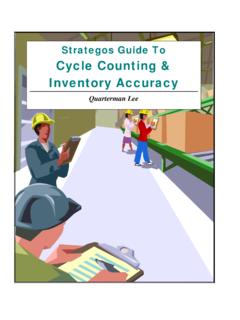Transcription of 1 Throughput, Work-in-Process, and Cycle Time
1 IEOR 4000: Production Managementpage 1 Professor Guillermo Gallego1 throughput , Work-in-Process, and Cycle TimeThe purpose of this section is to obtain a basic understanding of the relationship that exists betweenthroughput, work-in process, and Cycle times. We will assume a production system where parts gothrough a specific routing. Thethroughput, denoted byTH, is the average output per unit time, ,number of widgets per hour. The inventory between the start and the end points of a productionsystem (not counting crib inventory or finished goods inventory ) is calledwork-in-process(WIP).
2 Thecycle time(CT) of a given production system is the average time parts spend as bottleneck raterbis the rate of the process center having least long-term capacity. The rawprocessing timeTois the sum of the long-run average processing times of each workstation in therouting. Critical WIP is defined to beWo= 1: Consider a production line with four stations, and assume that the processing time ateach workstation is two hours. Since the processing rate at each of the workstations is , it follows thatrb= Since producing the part takes 2 hours in each workstation it followsthatTo= 8 so the bottleneck rate is half a unit per hour and the raw processing time is eight , critical WIP isWo=rbTo= 8= us find the Cycle time and the throughput rate for different WIP valueswassuming themachines are perfectly reliable and the processing times are deterministic.
3 What is the averagecycle time whenw Wo?Whenw Woparts do not have to wait soCT=Toforw ifw>Wo. In this case units have to wait soCT=w/rbforw>Wo. For throughput wehaveTH=w/Toforw Wo,andTH=rbforw> 2: For the data of example 1 we see thatCT=8forw 4andCT=2wforw>4. Asfor throughput we haveTH=.125wforw 4andTH= > : For any level of WIPw,wehaveTH=w/CT. This relationship actually holdsquite generally, and it is know as Little s Law. A balance deterministic line is the best we can hopefor, so in effect we haveCT CTbest={Toifw Wowrbifw>WoandTH THbest={wToifw Worbifw>WoIncreasing the bottleneck raterbimproves bothCTandTHon WIP levels aboveWo.}}
4 ReducingToimprovesCTandTHonly for WIP levels belowWo. In general, increasing the processing rateof bottleneck workstations, to the point that all workstations are balanced results in a system thatis more congested, compared to another one with the same bottleneck find the Cycle time and the throughput under the worst case, imagine that we transports jobsthrough the line on pallets. Whenever a job is finished, it is removed from its pallet and the palletimmediately returns to the front of the line to carry a new job. In this way, the WIP is kept constant,but now parts queue in front of each workstation.
5 To see this, consider what happens for our balanceline example withw= 4. When the pallet arrives at a workstation it finds the workstation idle. Thepallet stays at this workstation until all the units in the pallet are processed. This takes 8 there are 4 workstations, the Cycle time will be 32 hours and the throughput will be 1/8. Moregenerally, with a WIP equal towwe haveCTworst=wToandTHworst=1/Tofor allw CTworst=wToandTH THworst=1 ToVirtually no real-world line behaves according to either the best or the worst case and it isinstructive to consider intermediate cases.
6 We now consider a case where processing times areIEOR 4000: Production Managementpage 2 Professor Guillermo Gallegorandom. We will assume that the processing times are exponentially distributed. We say thata random variableTis exponentially distributed with parameter ifP(T>t)=e distribution is the only continuous time distribution with the memoryless property states that ifsunits have already elapsed and the processing has not been completed,the distribution of the additional time until completion is the same as if we were starting , this can be written asP(T>s+t|T>s)=P(T>t).
7 It is because of this property that some people say that the exponential distribution represents themaximum randomness although this is technically can be shown that under the exponential distribution,CT=To+w 1rbandTH=wWo+w will not go over the detailed derivation of these formulas. However, it is possible to give anintuitive justification of the formulas as follows. Suppose that you want to determine the Cycle timefor a particular job. Suppose that when you arrive at a station you expect the otherw 1jobstobe equally distributed amongNworkstations. In this case, you expect to seew 1 Njobs ahead ofyou.
8 If the processing time at each station isTo/Nthen the time you spend at each station is equaltoToN(1 +w 1N). Multiplying byNwe obtain the Cycle timeCT=To(1 +w 1N).Using Little s Law we can find the throughputTH=wCT=wWo+w 1rb,where we have used the fact thatWo=rbTo. The last two formulas define the practical worst case. Ifthe performance of a system is between the best case and the practical worst case then the system isbeen managed effectively. On the other hand, if the performance of a system is between the practicalworst case and the worst case, then there may be significant opportunities for Push and Pull SystemsA push system schedules the release of work based on demand forecasts, while a pull system autho-rizes the release of work based on system status.
9 In a push system we control the release of workalso known as the daily going rate and observe WIP. In a pull system we control WIP and : Five machines in tandem, each station processes jobs at a rate of one per hour, andprocessing times are exponentially distributed. Suppose we release jobs so that WIP stays at levelw. Then, the throughput is given byTH=w4+ suppose we release jobs into the same system at rateTH. ItcanbeshownthattheWIPlevel will beWIP=5TH1 , for example, to achieveTH=w/(4 +w), a push system would requireWIP= , or 25%more WIP than a pull system with constant 4000: Production Managementpage 3 Professor Guillermo GallegoSuppose our profit function is of the formpT H hw.
10 In a push system we need to determineTHto maximize the profit function. In a pull system we would controlwto maximize the the above problem, the PUSH profit function becomespT H h5TH1 TH,while for a pull system the profit function becomespw4+w this functions reveal that we can make more profit under a pull system, and that it is morerobust to errors in the optimal quantities.










